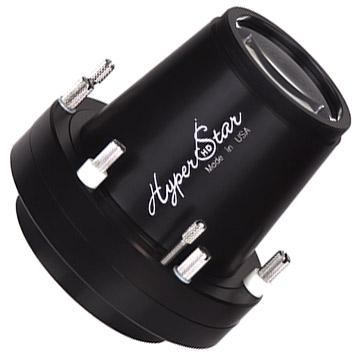
HyperStar FAQs
The HyperStar lens replaces the secondary mirror at the front of a Schmidt-Cassegrain telescope (SCT). Most SCTs operate at a focal ratio of f/10, which is very slow photographically. This requires a long exposure. The HyperStar lens converts the telescope to an f/2 optical system. This allows incredibly fast images, 25 times faster than at f/10! In addition to shorter images, the telescope does not need to be polar aligned, nor is guiding necessary. Deep-sky imaging is vastly easier than it used to be!
See a video of how easy HyperStar is to use on our YouTube channel StarizonaTV Why Do I Need a HyperStar Lens to Image at the Front of the Telescope?A Schmidt-Cassegrain telescope uses a primary mirror which has a focal ratio of around f/2. The secondary mirror provides a 5x magnification, yielding an overall f/10 system. Removing the secondary mirror and placing a camera at the front of the scope allows f/2 imaging. But without a corrective lens, the image would be awful. The primary mirror alone suffers from spherical aberration and field curvature which is normally minimized by the secondary mirror. The HyperStar is a multiple-element lens which corrects the inherent aberrations in the telescope, allowing f/2 imaging with a highly-corrected field of view.
Does the Corrector Plate Have to be Removed?No. A HyperStar-compatible telescope has a retaining ring, like the lid of a mason jar, that you simply unthread by hand to remove the secondary mirror. The mirror is attached to a plate with the collimation screws on it. This lifts out of a holder in the corrector plate (which also holds the baffle tube on the inside of the corrector plate). The mirror is safely stored in a protective holder while outside the telescope. The HyperStar lens attaches to the holder in the corrector plate. No tools are required and the corrector plate never comes off the scope.
How Safe is it to Put a Camera on the Corrector PlateVery safe. The weight of the camera and HyperStar are not more than a couple pounds. The thick corrector lens has no problem holding this weight and does not distort under the weight. For an impressive demonstration of what the corrector plate can hold, see this video.
What is the Image Quality Like with HyperStar?Excellent. The HyperStar lens uses a sophisticated, custom-designed optical system. There is a different HyperStar lens for each model of telescope, not just because the physical size must be different, but because the lenses are optimized for each telescope design. The result is a flat field of view which is sharp from edge to edge. The star images with HyperStar are much sharper than using the same telescope at f/10, despite the field of view being 5 times wider!
What Telescopes Are Compatible with HyperStar?Currently, the HyperStar system is available for Celestron 6", 8", 11" and 14" Schmidt-Cassegrain telescopes, including the new Edge HD models. A 9.25" model is also now available for Edge HD models. Some telescopes of these sizes will need to be converted to HyperStar compatibility. HyperStar requires the telescope to have an easily removable secondary mirror assembly. Fastar-compatible Celestron scopes, including Edge HD models, will already be compatible. For those which are not, Starizona offers conversion kits to retrofit most non-compatible telescopes.
Can I Use a Digital SLR Camera with HyperStar?The size of the CCD chip that can be used on the HyperStar lens is dependent on the telescope used. The bigger the telescope, the bigger the HyperStar lens, and thus the larger the chip which can be illuminated by the HyperStar system. Digital SLRs are compatible with 14" HyperStar lenses and the 11" and 9.25" HyperStar 3 lenses, but not the smaller models or the original HyperStar C11 or C14.
Can I Still Use My Telescope Visually with HyperStar?You can easily switch between the standard f/10 (visual) configuration and the f/2 HyperStar configuration. Converting from one to the other takes less than 5 minutes. Since the secondary mirror is removed for HyperStar imaging, viewing cannot be done simultaneously, but the image can be viewed via the CCD camera on the computer screen. A 1-second focus exposure will show more than your eye would ever see at the eyepiece! This makes finding and framing objects very simple.
Do I Have to Collimate My Telescope Each Time I Use the HyperStar Lens?No. The secondary mirror is indexed so it goes back into the telescope exactly the way it came out. This retains the alignment of the optics precisely, eliminating the need to recollimate after HyperStar imaging.
How Do You Focus the Telescope with the HyperStar Lens Installed?Focus is achieved using the standard focus knob on the telescope (moving the primary mirror). The image is seen on the computer screen via the CCD camera, so focusing is very easy. Autofocusing is also possible using a motorized focuser such as Starizona's Wireless MicroTouch Autofocuser. Despite focusing with the primary mirror rather than a Crayford-type focuser, mirror shift is not an issue. Remember that the image from the primary mirror in an SCT is normally magnified 5 times by the secondary mirror. With HyperStar, the secondary is removed so any mirror shift is reduced five-fold. The field of view is so wide with HyperStar that any image shift is not an issue.
Can I Use HyperStar for Lunar and Planetary Imaging?HyperStar is ideal for deep-sky imaging but is not well-suited to solar system imaging. For planetary imaging you need very high magnification, the opposite of what the HyperStar gives. While the moon may be framed well using the HyperStar lens, the system is so sensitive that it will be all but impossible to avoid overexposing the moon.
Are There Any Disadvantages to Using HyperStar? You won't sleep anymore.
